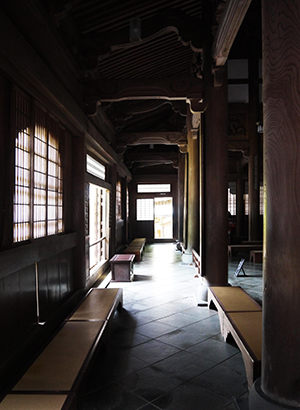


永平寺は禅宗の道場建築。中核建築はこの仏殿と法堂になる。
仏堂は山門から見上げる位置にあり、さらに奥の上にある法堂との中間に位置。
ここに永平寺の本尊・釈迦牟尼仏、弥勒菩薩、阿弥陀仏という3仏が集合。
釈迦牟尼はこの世に救済をもたらしたお釈迦さまであり、
来世、極楽浄土を支配する阿弥陀仏の世界まで衆生を導き送り、
さらに56億7,000万年後の未来の救済者である弥勒という3者が祀られる。
・・・仏教建築を探究するウチにだいぶ仏の概念が「入って」きた。
年齢的にもこういった建築探究はありがたい機縁なのかなぁ(笑)。
この仏殿では道元が修行した宋の寺院建築様式・基壇建築が採用されている。
明治35年の改築というなので、創建時以来、
この建築はこういった「宋朝」の建築仕様を順守してきたと思われる。
宋大工・玄氏はこの建築様式を正しく起ち上げる総指揮を執ったのかも。
建築としては以前見たように、石を積層させた基礎〜基壇を築き、
その上に直接、礎石を置いて柱を立ち上げる。従ってこの堂だけが土間床。
多雨気候の日本では多数派にはならなかった大陸由来の建築工法。

どうして日本では仏教建築で土間から床上げという進化があったのか。
やはり冬期の床面の温度低下ということも大きかったのだろうか。
たしかにこの写真のような床面では最低気温がマイナス5度程度に下がる
越前の気候風土を考えれば素足では厳しい。
いや、日本は四季変化が明瞭な風土であり温暖地域でも冬期の寒さはキツい。
それに加えて夏期の湿潤気候があって建築的に床上げ方向に進化したのか。
直感的にはどうもそう思われる。
社会を先導するような仏教・宗教施設建築でこの建築史的選択・床上げが行われ
やがて貴族階級の書院建築などから床上げが基本スタイルになっていく。
室内では靴を脱ぐ習慣が全面的に民族に根付いていった。
たしかに大陸からの導入期の飛鳥寺や法隆寺では室内は土間のままという
参観記憶があるが以降の寺院建築ではおおむね「靴を脱いで」の参観が普通。
こういった仏教寺院の建築様式進化・選択が契機となって
室内での「素足」習慣が日本人のライフスタイルとして定着していった。
床上げして土間から徐々に離れたプロセスは民家の歴史を見てくるとよくわかる。
今回の感染症世界蔓延のなかで日本がかなり軽度被害である
ひとつの大きな理由がこうした建築工法を社会全体で採用していることが
やはり大きな要因と考えられないだろうか。
感染症、とくにウィルスにとっては室内で素足という生活文化は
なかなか人体に付着しにくい環境だと言える。
その上、ケガレへの忌避感が強くよく掃除を欠かさないマジメな民族性。
世界で家の中で靴脱ぎ習慣は日本人だけといえる。
建築ジャーナリズム活動をしてきた人間として強い実感がある。
仏教というのは世界のなかでも日本は奇跡的に多数派として受容し、
そしてその文化が民族の暮らしにも深く根を下ろしていった稀有な国。
もし、こうした建築文化が感染症対応に有効であるとすれば、
気候風土対応した仏教建築文化がわたしたちを救ってくれているのかも知れない。
English version
[Relationship between infectious diseases and floor surface “base ceremony, Buddhist temple” Eiheiji-8]
Eiheiji is a Zen Buddhist dojo architecture. The core architecture will be this Buddhist temple and the temple.
The Buddhist temple is located looking up from the mountain gate, and further in the middle of the temple above the back.
Three Buddhas, Shakyamuni Buddha, Maitreya Bodhisattva, and Amida Buddha, who are the principal idols of Eiheiji Temple, are gathered here.
Shakyamuni is even the Buddha who brought salvation to the world.
In the afterlife, he will lead sentient beings to the world of Amida Buddha, who will rule the Pure Land of Sukhavati.
In addition, three people, Miroku, who will be the future rescuer 5.67 billion years later, are enshrined.
… The concept of Buddhism has “entered” in my exploration of Buddhist architecture.
I wonder if this kind of architectural exploration is a good opportunity in terms of age (laughs).
In this Buddhist temple, the Song dynasty’s temple architecture and foundation architecture that Dogen trained are adopted.
Since it was rebuilt in 1902, it has been since its foundation.
This architecture seems to have adhered to these “Song Dynasty” architectural specifications.
Song carpenter Gen may have taken the overall command to properly launch this architectural style.
As for the architecture, as we saw before, we built a foundation with laminated stones and a foundation.
Place the cornerstone directly on it and set up the pillar. Therefore, only this hall is a dirt floor.
A continent-derived construction method that did not become the majority in Japan, which has a heavy rainfall climate.
Why did Buddhist architecture evolve from the dirt floor to raising the floor in Japan?
I wonder if the temperature drop on the floor in winter was also a big factor.
Certainly, on the floor like this picture, the minimum temperature drops to about -5 degrees Celsius.
Considering the climate of Echizen, it is difficult to barefoot.
No, Japan has a climate with clear changes in the four seasons, and even in warm regions, the cold in winter is tough.
In addition to that, did it evolve in the direction of raising the floor architecturally due to the humid climate in summer?
Intuitively, that seems to be the case.
This architectural historical selection and floor raising was carried out in the construction of Buddhist and religious facilities that lead the society.
Eventually, raising the floor became the basic style from the aristocratic class of Shoin architecture.
The custom of taking off shoes has taken root in the people indoors.
It is true that the interior of Asuka-dera and Horyu-ji temples, which were introduced from the continent, is still in the dirt floor.
I remember visiting the temple, but in the temple architecture after that, it is common to visit “take off your shoes”.
The evolution and selection of the architectural style of these Buddhist temples became an opportunity.
The indoor “barefoot” habit has become established as a Japanese lifestyle.
The process of raising the floor and gradually moving away from the dirt floor can be easily understood by looking at the history of private houses.
Japan is fairly mildly damaged in this infectious disease world epidemic.
One major reason is that these construction methods are being adopted by society as a whole.
Isn’t it considered a big factor?
For infectious diseases, especially viruses, the living culture of bare feet indoors
It can be said that it is an environment that does not easily adhere to the human body.
In addition, he has a strong sense of repulsion against injuries and has a serious ethnicity that does not lack cleaning.
It can be said that only Japanese people have the habit of taking off their shoes at home in the world.
I have a strong feeling as a person who has been engaged in architectural journalism activities.
Buddhism is miraculously accepted by Japan as a majority in the world.
And a rare country where the culture has taken root deeply in the lives of the people.
If this architectural culture is effective in dealing with infectious diseases,
The Buddhist architectural culture that corresponds to the climate may have saved us.
Posted on 12月 5th, 2021 by 三木 奎吾
Filed under: 住宅マーケティング, 日本社会・文化研究








コメントを投稿
「※誹謗中傷や、悪意のある書き込み、営利目的などのコメントを防ぐために、投稿された全てのコメントは一時的に保留されますのでご了承ください。」
You must be logged in to post a comment.